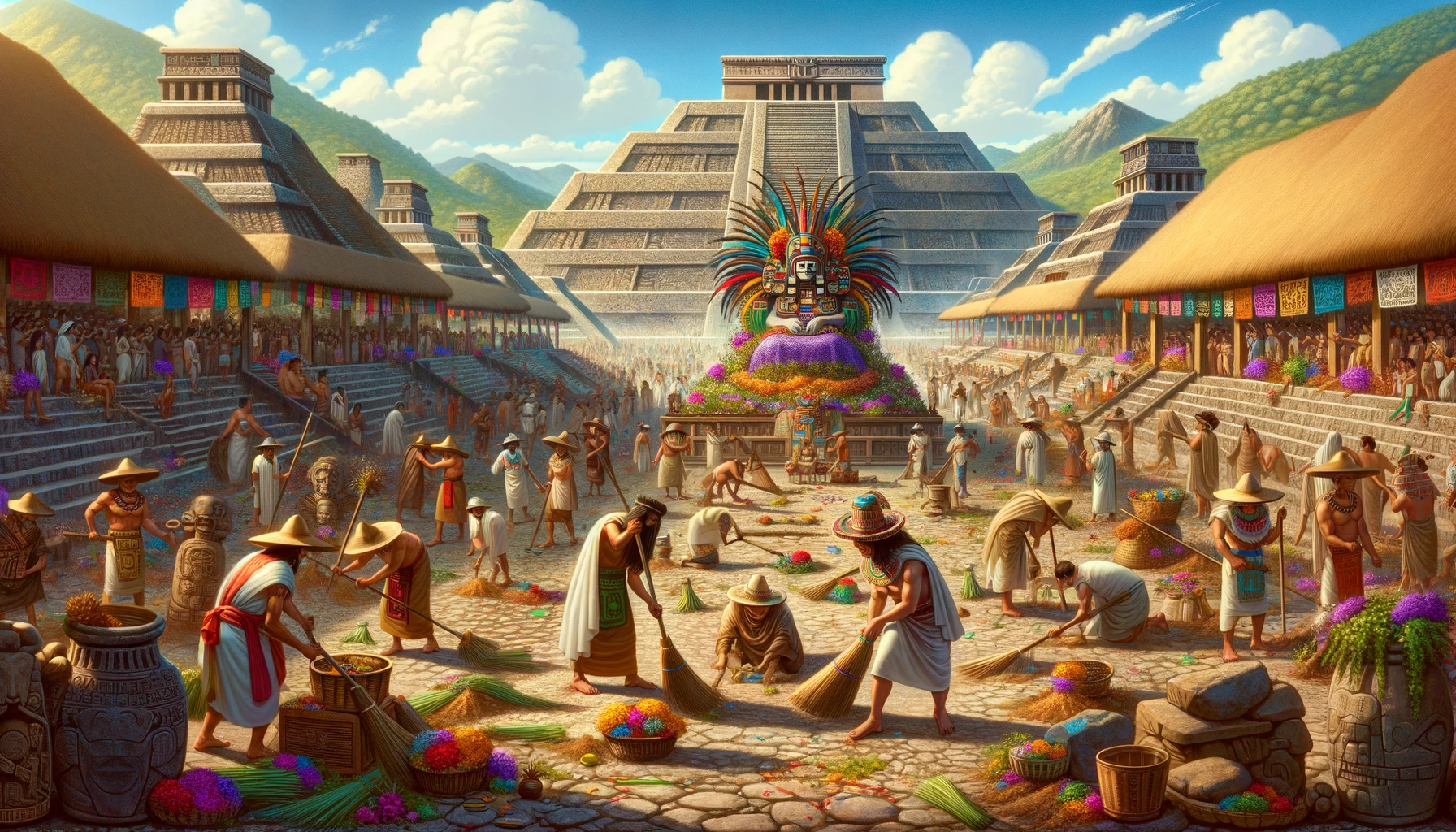
In the annals of Aztec culture, amidst the bustling streets of Tenochtitlan, the capital of the Aztec Empire, the Ochpaniztli festival emerged as a vibrant celebration dedicated to cleansing paths and roads while venerating Toci, the revered goddess of healing and fertility. This sacred festival not only symbolized the physical cleansing of the environment but also served as a spiritual purification, reaffirming the Aztec connection to the natural world and the divine forces believed to govern it.
Ochpaniztli, meaning "Sweeping of the Roads" or "Sweeping of the Paths," was the eighth month in the Aztec solar calendar, typically falling between late September and early October in the Gregorian calendar. As the harvest season waned and the transition to the dry season approached, the Aztecs engaged in rituals aimed at purifying the land, renewing fertility, and ensuring the well-being of their communities.
Central to the Ochpaniztli festival was the veneration of Toci, the primordial goddess associated with healing, fertility, and domestic arts. Often depicted as an elderly woman with wrinkled skin and a crooked back, Toci embodied the nurturing aspects of feminine divinity and was revered as a guardian of life and sustenance. Her influence extended beyond physical health and fertility to encompass the well-being of families, communities, and the natural world.
The rituals of Ochpaniztli were designed to honor Toci and invoke her blessings upon the people and the land. Priests and devotees would engage in acts of purification, including sweeping and cleansing roads, pathways, and sacred sites. This symbolic act of physical cleanliness was believed to have spiritual significance, purging the environment of negative energies and inviting the presence of Toci's healing and fertility powers.
In addition to the sweeping rituals, the Ochpaniztli festival featured offerings of food, flowers, and incense to Toci, symbolizing gratitude for her benevolence and supplication for her continued favor. Ceremonial dances, music, and performances enlivened the festivities, bringing together communities in joyful celebration of life, renewal, and the divine presence of Toci.
While the Ochpaniztli festival lacked the elaborate sacrificial rites associated with some other Aztec ceremonies, its emphasis on purification, fertility, and communal harmony reflected the core values of Aztec spirituality. Through their rituals and observances, the Aztecs sought to maintain balance and reciprocity with the natural world, recognizing the interconnectedness of all living beings and the cycles of birth, growth, decay, and regeneration.
Despite the eventual conquest of the Aztec Empire by the Spanish conquistadors and the suppression of indigenous religions, the legacy of the Ochpaniztli festival endures as a testament to the enduring spirit of the Aztec people and their profound reverence for the forces of life and creation. In its celebration of cleansing, healing, and fertility, the Ochpaniztli festival continues to resonate as a timeless expression of humanity's quest for connection, renewal, and transcendence.
Ochpaniztli, meaning "Sweeping of the Roads" or "Sweeping of the Paths," was the eighth month in the Aztec solar calendar, typically falling between late September and early October in the Gregorian calendar. As the harvest season waned and the transition to the dry season approached, the Aztecs engaged in rituals aimed at purifying the land, renewing fertility, and ensuring the well-being of their communities.
Central to the Ochpaniztli festival was the veneration of Toci, the primordial goddess associated with healing, fertility, and domestic arts. Often depicted as an elderly woman with wrinkled skin and a crooked back, Toci embodied the nurturing aspects of feminine divinity and was revered as a guardian of life and sustenance. Her influence extended beyond physical health and fertility to encompass the well-being of families, communities, and the natural world.
The rituals of Ochpaniztli were designed to honor Toci and invoke her blessings upon the people and the land. Priests and devotees would engage in acts of purification, including sweeping and cleansing roads, pathways, and sacred sites. This symbolic act of physical cleanliness was believed to have spiritual significance, purging the environment of negative energies and inviting the presence of Toci's healing and fertility powers.
In addition to the sweeping rituals, the Ochpaniztli festival featured offerings of food, flowers, and incense to Toci, symbolizing gratitude for her benevolence and supplication for her continued favor. Ceremonial dances, music, and performances enlivened the festivities, bringing together communities in joyful celebration of life, renewal, and the divine presence of Toci.
While the Ochpaniztli festival lacked the elaborate sacrificial rites associated with some other Aztec ceremonies, its emphasis on purification, fertility, and communal harmony reflected the core values of Aztec spirituality. Through their rituals and observances, the Aztecs sought to maintain balance and reciprocity with the natural world, recognizing the interconnectedness of all living beings and the cycles of birth, growth, decay, and regeneration.
Despite the eventual conquest of the Aztec Empire by the Spanish conquistadors and the suppression of indigenous religions, the legacy of the Ochpaniztli festival endures as a testament to the enduring spirit of the Aztec people and their profound reverence for the forces of life and creation. In its celebration of cleansing, healing, and fertility, the Ochpaniztli festival continues to resonate as a timeless expression of humanity's quest for connection, renewal, and transcendence.